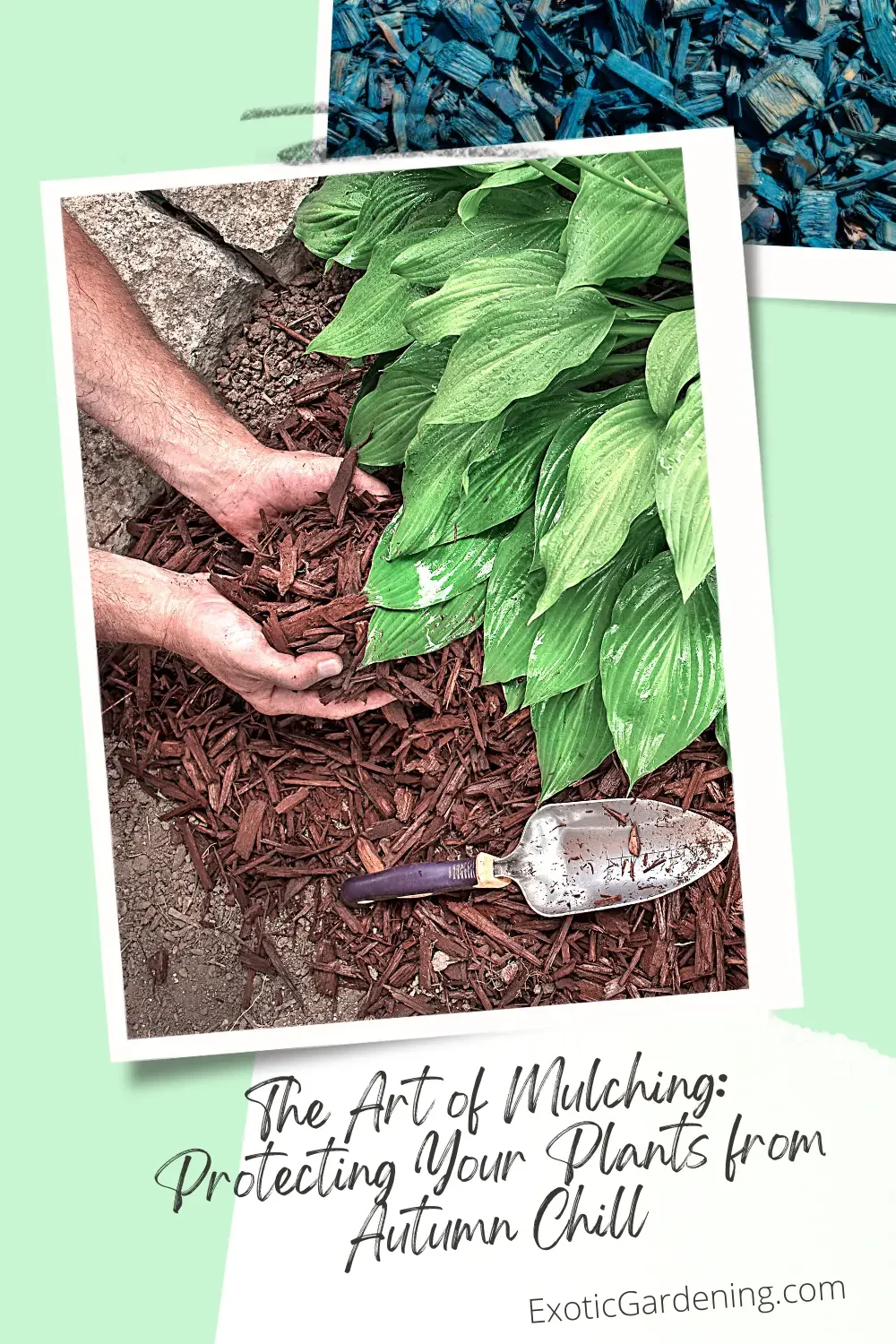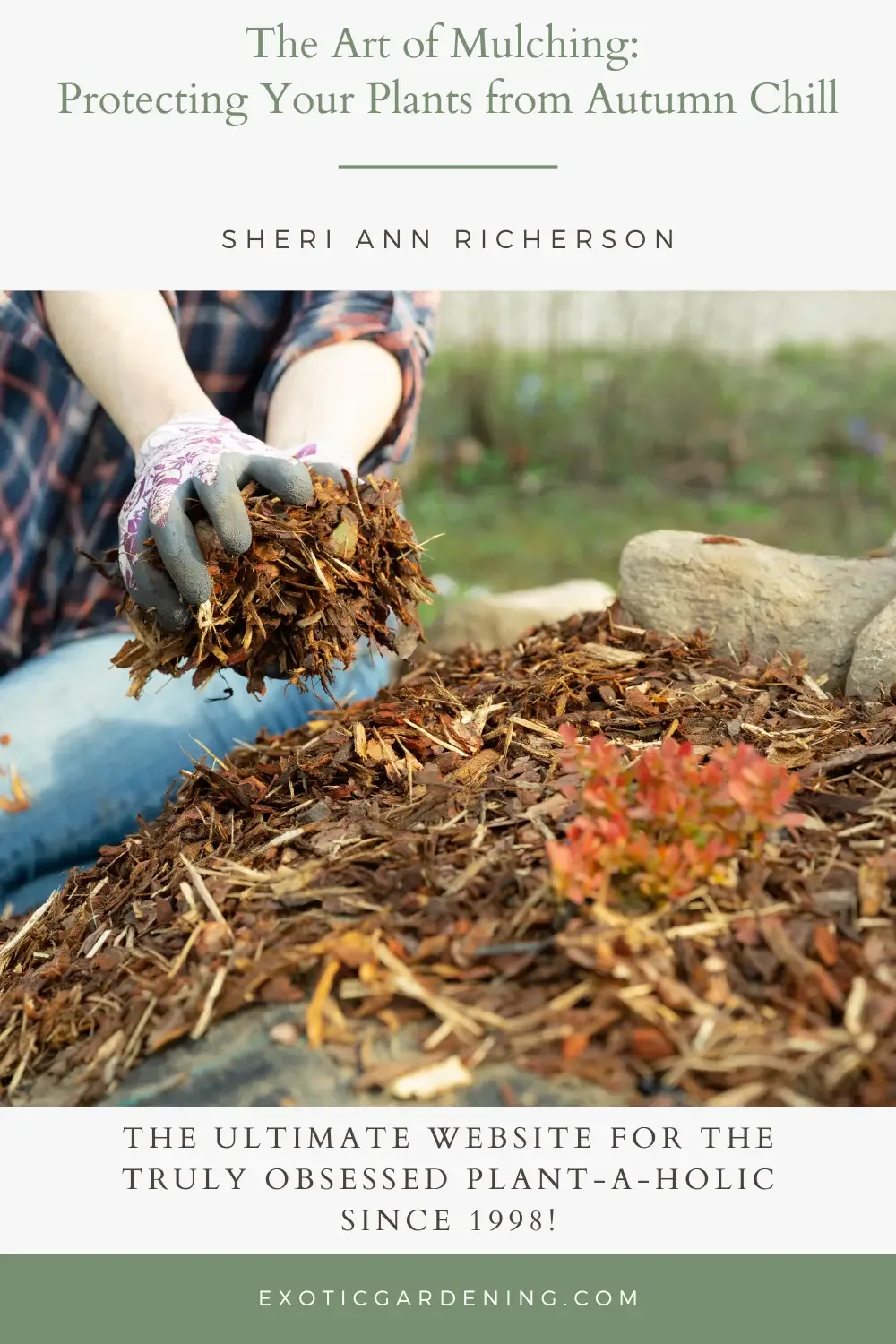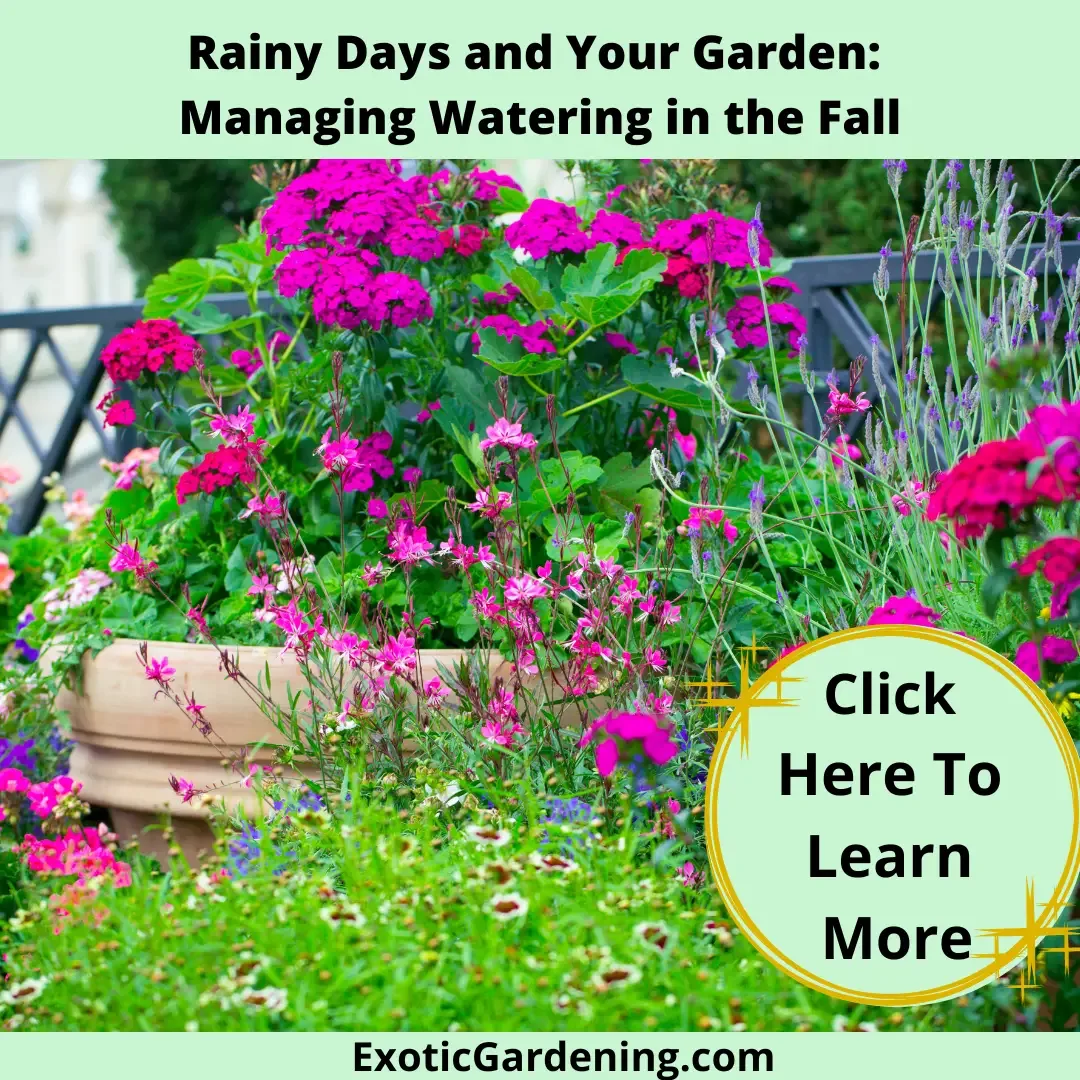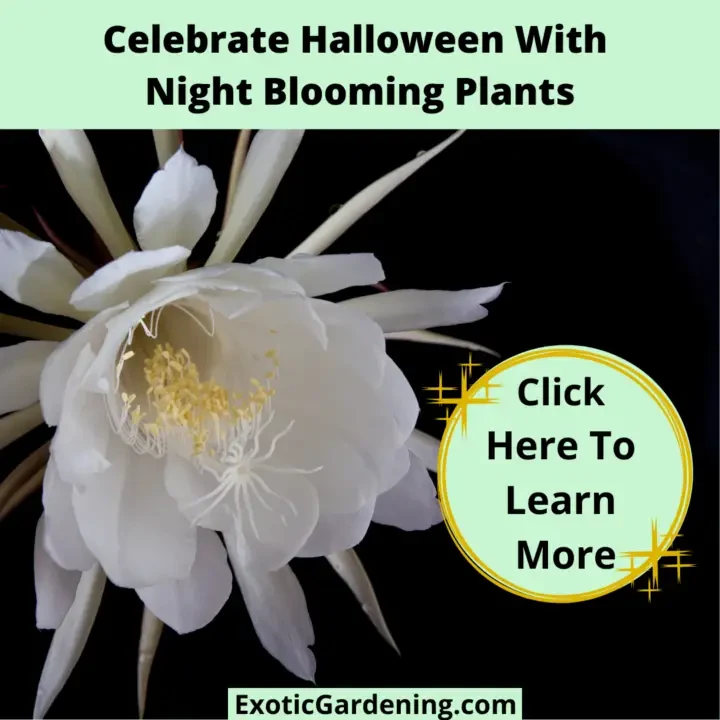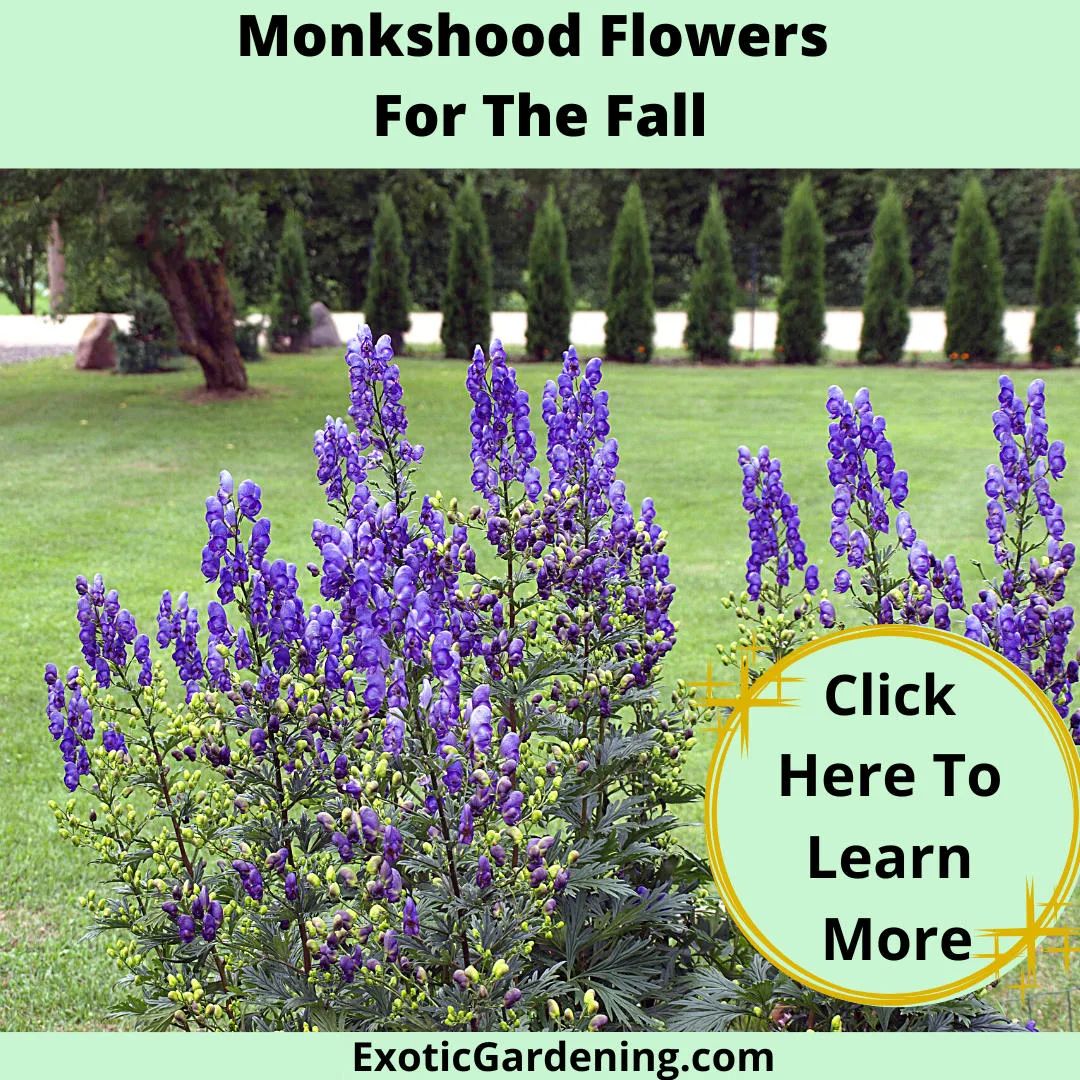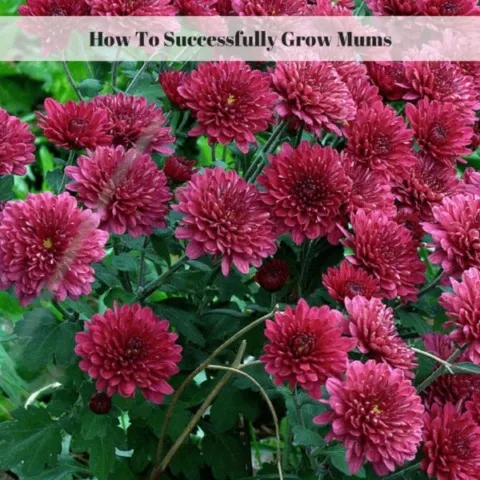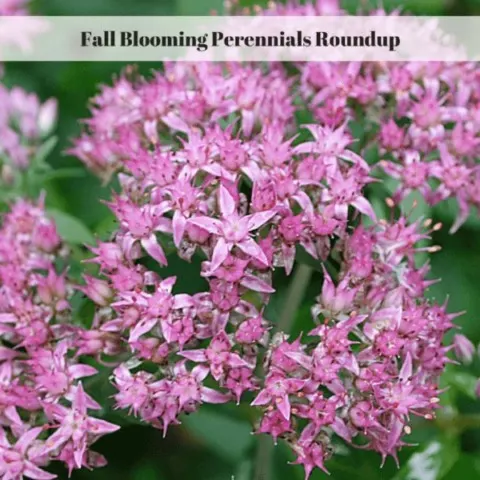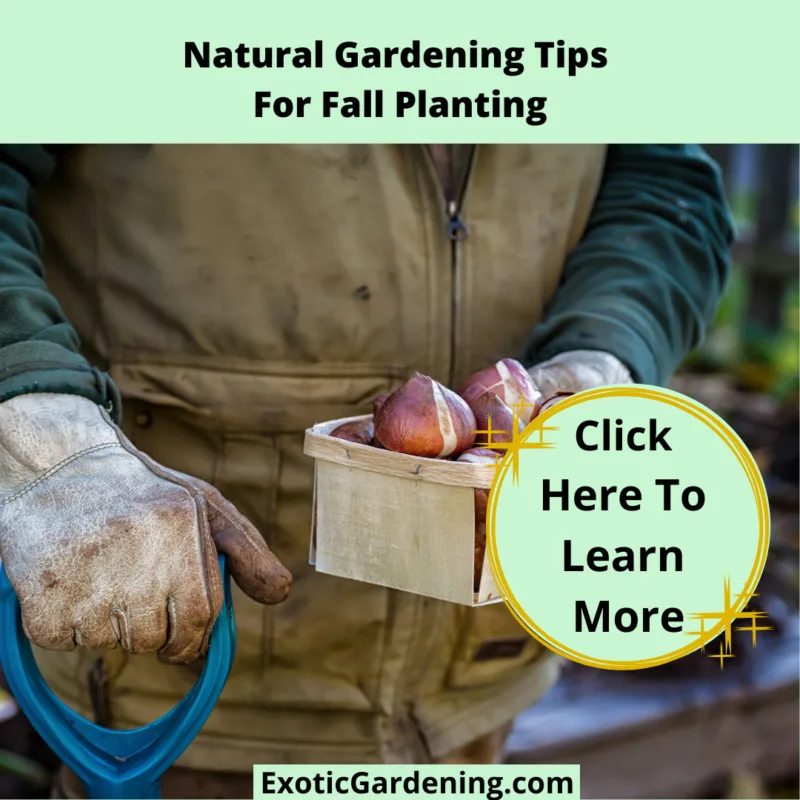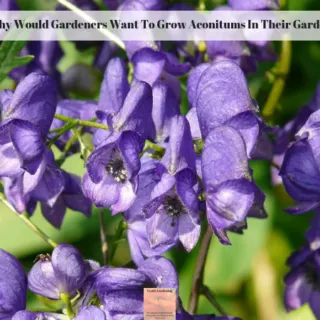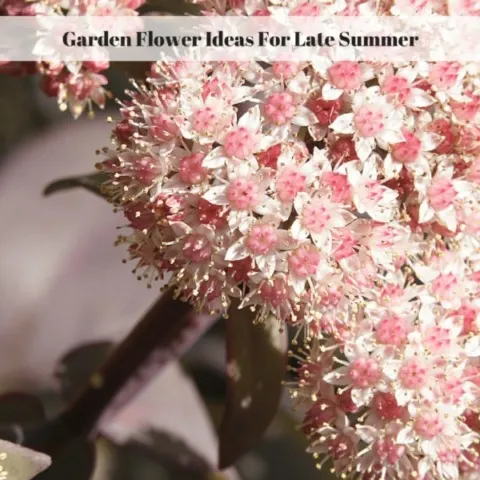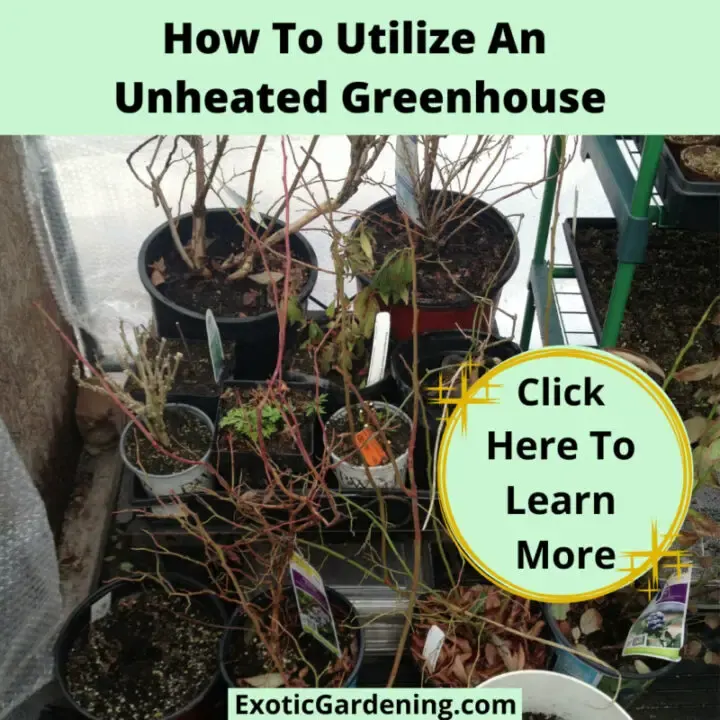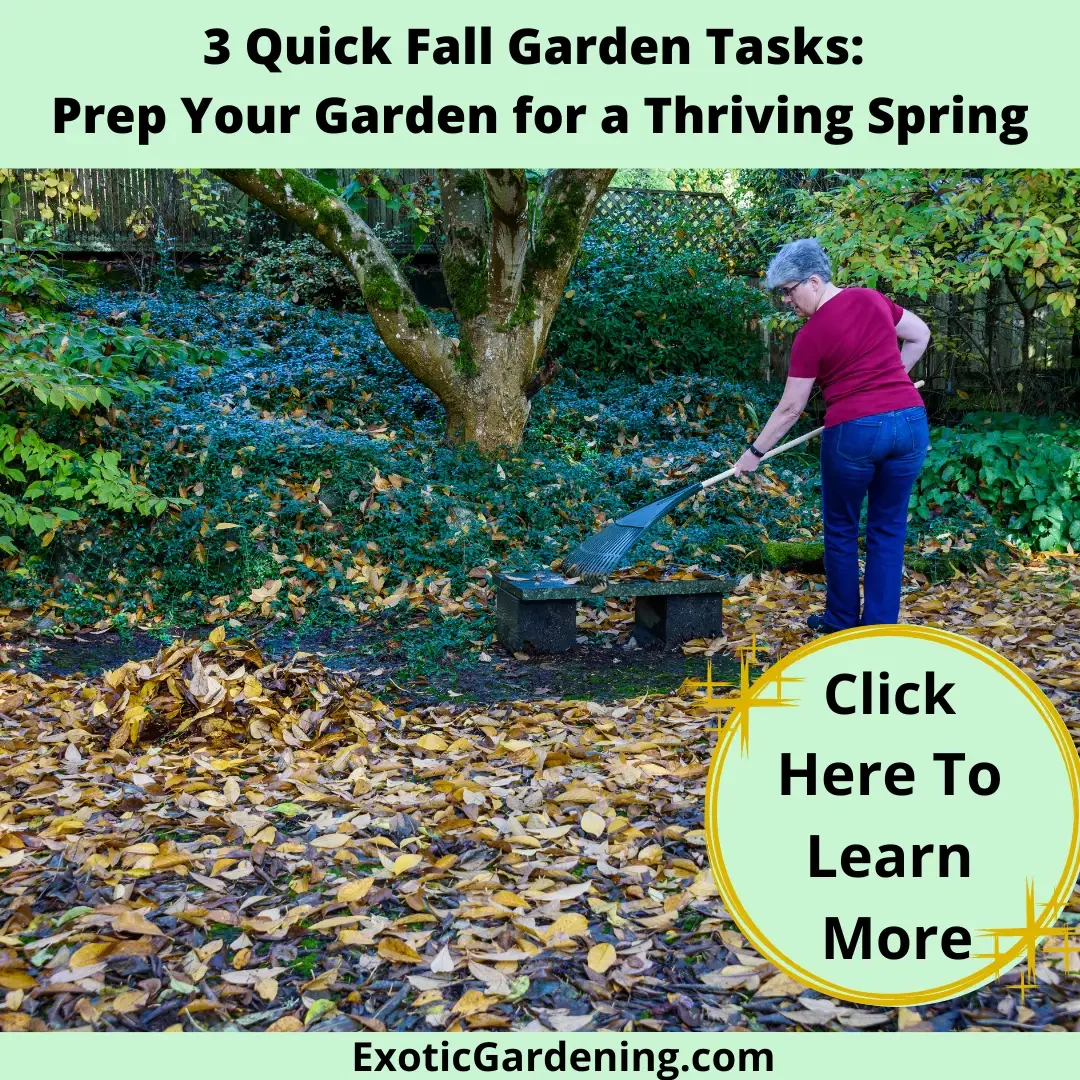Providing a protective blanket for your plants, especially during the autumn chill, can make all the difference in your garden's health and vitality.
As temperatures drop and the first signs of frost appear, your plants, particularly their roots, become vulnerable to the cold.
This exposure can result in stunted growth or even plant loss.
That's where the art of mulching comes into play.
Mulch acts as a protective layer, insulating the roots from harsh weather conditions and helping to maintain a stable soil temperature, ensuring warmth during the colder months.
By creating a barrier between the soil and the air, mulch prevents rapid temperature fluctuations that can stress your plants.
But mulch does more than protect against the cold.
It's a pro at retaining moisture in the soil, which is crucial during dry spells.
By reducing evaporation, mulch keeps the soil moist for extended periods, providing your plants with a consistent water supply.
Moreover, mulch acts as a natural weed suppressant by blocking sunlight from weed seeds, preventing them from germinating and taking over your garden.
This translates to less time spent weeding and more time enjoying your thriving plants.
As mulch breaks down over time, it enriches the soil with organic matter, improving its structure and fertility, creating an ideal environment for your plants to flourish.
So, as you prepare your garden for the autumn season, don't forget the importance of mulching.
It's a simple yet highly effective way to protect your plants and ensure their well-being throughout the colder months.
But the story of mulching doesn't end here.
If you're curious to explore further and discover the finer nuances of this gardening technique, we've got you covered.
Dive into our in-depth guide on mulching, where we'll take you through the art and science of this garden-saving practice in the rest of the post.
Why Mulching Matters
Fall, with its cooler temperatures and the looming threat of frost, is undoubtedly a breathtaking season.
Yet, it can be quite challenging for our cherished plants.
Fortunately, in this tale of autumn's challenge, mulch emerges as the valiant knight in shining armor, equipped with a versatile set of tools.
As the temperatures drop, your plants, especially their roots, shiver in the cold, vulnerable to potential damage that could hinder their growth or, worst-case scenario, lead to their demise.
But behold, mulch steps in as a lifesaver, creating a protective shield against the unforgiving weather conditions.
It's like a warm, cozy blanket, insulating the roots and maintaining a stable soil temperature, preventing the abrupt fluctuations that could stress our green companions.
Yet, the magic of mulch doesn't stop here.
It's also a master of moisture retention, a crucial trait when facing dry spells.
By curbing water evaporation, it ensures the soil remains consistently moist, guaranteeing your plants a steady water supply, even when rain is scarce.
Mulch, however, isn't a one-trick pony.
It excels as a formidable weed suppressor, thwarting weed seeds' attempts to germinate and take over your garden.
Bid farewell to endless weeding and welcome more quality time enjoying your flourishing plants.
And here's the grand finale: as mulch gradually breaks down over time, it enriches the soil with organic matter.
This boost enhances the soil's structure and fertility, nurturing an environment where your plants can truly thrive.
So, why does mulching matter?
Let's break it down:
- Protection from Cold: Mulch acts as a protective shield, insulating your plants' roots from harsh weather conditions, preventing cold-related damage.
- Moisture Retention: It reduces water evaporation, keeping the soil consistently moist, ensuring your plants have a steady water supply, even during dry spells.
- Weed Suppression: Mulch effectively blocks sunlight from weed seeds, preventing them from germinating and taking over your garden, reducing the time spent on weeding.
- Soil Enrichment: Over time, as mulch breaks down, it enriches the soil with organic matter, improving its structure and fertility, creating an ideal environment for your plants to thrive.
Mulch is your garden's best friend, offering protection, moisture retention, weed control, and soil enhancement.
By incorporating mulch into your gardening routine, you're not just safeguarding your plants but also ensuring their well-being throughout the colder months.
So, this autumn, don't forget to mulch your garden and enjoy the multitude of benefits it brings to your cherished green space.
Your garden will thank you with a flourish of vibrant life.
The Many Faces of Mulch
When it comes to mulch, you're faced with a delightful array of options, each with its own distinct advantages.
Let's take a journey into the world of mulch and discover how these different types can work wonders for your garden.
- Organic Mulch: This category includes materials like shredded leaves, straw, or compost. Organic mulch not only shields your plants from the elements but also contributes to soil enrichment as it breaks down over time. As it decomposes, it releases valuable nutrients into the soil, improving its fertility. It creates a nurturing environment for your plants to flourish. It's a win-win for both your garden and the soil beneath.
- Inorganic Mulch: In this group, you'll find rocks, gravel, and landscape fabric. While they may not enrich the soil like organic mulch, they have their own unique strengths. Inorganic mulch is a champion when it comes to suppressing weeds. It forms a protective barrier, thwarting weed seeds from germinating and taking over your garden. These options also offer a polished, elegant appearance to your outdoor space.
- Wood Chips: Wood chips add a natural and rustic touch to your garden. They decompose slowly, reducing the need for frequent replacement, making them a low-maintenance choice. Additionally, they provide insulation for your plants, helping to regulate soil temperature and protect roots from extreme weather conditions.
- Straw Mulch: If you have a vegetable garden, straw mulch is an excellent choice. It's both affordable and effective at retaining moisture in the soil. Straw acts as a barrier, preventing water evaporation and ensuring your plants have a constant water supply, even during dry spells. It also plays a role in regulating soil temperature, keeping it cooler in the summer and warmer in the winter, creating the ideal environment for your vegetables to thrive.
- Rubber Mulch: Made from recycled tires, rubber mulch is long-lasting and perfect for play areas, providing a soft surface for children. However, it's worth noting that rubber mulch doesn't enhance soil quality like organic options do. So, if you're looking to enrich your soil, you might want to consider other mulching materials.
Whether you opt for organic mulch for its soil-enriching properties, inorganic mulch for weed control, wood chips for a natural aesthetic, straw mulch for vegetable gardens, or rubber mulch for play areas, mulching is an essential practice to safeguard your plants and enhance your garden's overall health.
Take a moment to ponder the unique benefits of each type of mulch and choose the one that best aligns with your gardening needs.
The Pros and Cons of Free Mulch: Weighing the Benefits and Drawbacks
Gardening enthusiasts often look for cost-effective and sustainable ways to enhance their gardens, and free mulch can be an appealing option.
While it offers several advantages, it's crucial to consider the potential drawbacks before incorporating it into your garden.
Let's explores the pros and cons of using free mulch, helping you make an informed decision about this resource.
From the benefits of reducing waste and saving money to the potential risks of introducing pests and affecting soil nitrogen content, we'll delve into all aspects of free mulch to help you determine if it's the right choice for your gardening needs.
- Advantages: Free mulch offers a range of benefits for gardeners. It's a sustainable and budget-friendly option that not only reduces waste but also enhances the visual appeal of your garden. Utilizing free mulch can help you save money that you might have otherwise spent on purchasing mulch. By recycling organic materials, you contribute to environmental sustainability while improving your garden's overall health.
- Disadvantages: On the flip side, there are potential drawbacks to consider when using free mulch. One significant concern is the possibility of introducing pests and diseases into your garden. Free mulch is often sourced from various locations, and it may carry unwanted guests or pathogens that could harm your plants. Additionally, many free mulches, especially those obtained from tree removal services, have high carbon-to-nitrogen ratios. This means they can rob your soil of nitrogen as they decompose, potentially affecting your plants' growth. To address this issue, it's typically recommended to let free mulch sit for a year before applying it to your garden. Allowing it to decompose during this time helps stabilize its nitrogen content, making it more suitable for your plants.
In conclusion, while free mulch offers an eco-friendly and cost-effective option, it's essential to weigh these advantages and disadvantages carefully before incorporating it into your gardening routine.
By being aware of potential issues and taking appropriate measures, you can make the most of this resource while safeguarding the well-being of your garden.
How To Apply Mulch
Now, let's dive into the nitty-gritty of mulch application.
To make sure your mulch does its job just right, follow these steps:
- Clear the Area: The first step is to prepare the ground properly. Clear the area where you plan to mulch by getting rid of any weeds or debris. This is like giving your garden a fresh start. When you clear the area, you eliminate competition for nutrients, creating a healthier environment for your plants.
- Add a Layer: Once the canvas is clean, it's time to add that layer of mulch. For your existing plants, spread the mulch about 2-4 inches deep around the base of the plants. But here's a pro tip: be cautious not to heap the mulch right up against the plant stems. This can lead to problems like rot and can become a welcoming home for pests and diseases. Instead, create a little gap between the mulch and the stems to allow for some air circulation.
- Mulch in the Right Season: Timing is key when it comes to mulching. Fall is a fantastic season for mulching because it preps your garden for the upcoming winter. The layer of mulch acts like a cozy blanket, shielding the soil and roots from the chilly temperatures. It also works its magic in retaining moisture, preventing the soil from drying out during those cold months. Spring is another prime season for mulching, especially as it helps lock in moisture when the temperatures rise, and your plants spring back to life.
- Water First: Before spreading that mulch, give your plants a good drink. A thorough watering session before mulching is like a hydration boost for your green friends. It locks in moisture, ensuring your plants stay well-hydrated during the dry autumn days. This is especially crucial if you're in an area with limited rainfall or facing a drought. Watering first guarantees that your plants have enough moisture to carry them through until the next watering.
- Top Up as Needed: Remember, mulch isn't forever; it naturally breaks down over time. So, make it a habit to check your garden beds regularly and add more mulch when it starts to thin out. As the mulch breaks down, it releases valuable nutrients into the soil, enriching its fertility. By topping up the mulch, you maintain a consistent layer that provides insulation, keeps weeds at bay, and retains moisture. This ensures your plants stay snug and content throughout the season, promoting their healthy growth.
By following these steps, you can be sure your mulch does its job with finesse.
Clearing the area, adding the right layer of mulch, timing your mulching, giving your plants a good drink before mulching, and topping up when necessary are all essential practices for successful mulching.
So, take the time to apply mulch properly and savor the wonderful benefits it brings to your garden.
Mulch: A Gardener's Shared Journey
In the world of gardening, mulching isn't just a practical technique; it's a way to connect with fellow green thumbs.
When you share your experiences and discuss your favorite mulching methods, you become part of a community of passionate gardeners dedicated to creating vibrant, welcoming gardens throughout the autumn.
Mulching, at its core, is a simple yet remarkably effective way to protect your beloved plants from the autumn chill.
It's like a warm, protective embrace for your garden, insulating the soil and roots from the cold temperatures.
Moreover, it's a master at retaining moisture, ensuring the soil stays nourished during the winter months.
But remember, there's an art to applying mulch correctly.
Clear the area, add that perfect layer of mulch, time it just right, give your plants a good drink before mulching, and don't forget to top up when needed.
These steps ensure that your mulch performs its job effectively and keeps your plants in the peak of health.
So, as you embark on your mulching journey, embrace the opportunity to share your experiences and engage in conversations with fellow gardeners.
Together, we're crafting beautiful and thriving gardens that bring joy and tranquility throughout the autumn season.
Let's Talk Mulch: Your FAQs Answered
Q. What's the best time of year to apply mulch?
A. The best times to apply mulch are typically in the spring and fall. Late spring and early fall are ideal, but avoid mulching during late fall when the ground is cold, as it may insulate the cold instead of protecting your plants.
Q. Are there any plants that don't like mulch?
A. While most plants benefit from mulch, some succulents and cacti prefer not to be mulched because it can trap too much moisture around their roots.
Q. Can I make my own mulch at home?
A. Absolutely! You can create homemade mulch from materials like shredded leaves, grass clippings, or compost. If you have a chipper shredder, you can chop up small tree and shrub branches. Just ensure they're well-shredded and weed-free.
Q. Does mulch have an expiration date?
A. Mulch doesn't exactly expire, but it decomposes over time. You'll know it's time for a refresh when it starts to thin out or lose its color.
Q. Are there any downsides to over-mulching?
A. Yes, over-mulching can lead to issues like root rot and excessive moisture retention, which isn't suitable for all plants. It's essential to strike the right balance.
Q. What's the environmental impact of using rubber mulch?
A. Rubber mulch is made from recycled tires, which can be a plus for recycling. However, there are debates about potential environmental impacts and health concerns due to the materials in the tires. I do not recommend using rubber mulch around edible plants.
Q. How do I choose the right mulch color for my garden's aesthetics?
A. When selecting mulch color, consider the overall look of your garden. Lighter mulches brighten up the space, while darker ones offer a more natural appearance.
Q. Can I use mulch for indoor potted plants?
A. Yes, you can use mulch for indoor plants in pots. It helps retain moisture and adds a polished look to your indoor garden.
Q. Are there any pests or diseases that can be associated with mulch?
A. While mulch itself doesn't attract pests, it can provide shelter for some insects. Occasionally, mold or mildew may develop under mulch, but this is usually not a significant issue.
Q. How do I deal with mold or mildew issues in mulch?
A. To address mold or mildew, carefully rake or fluff the mulch to increase air circulation. This should help reduce moisture buildup.
Q. Are there specific mulching practices for raised beds or container gardens?
A. For raised beds and containers, apply mulch as you would in-ground gardens, but use smaller pieces to avoid compaction. Container gardens may require less mulch to prevent overwatering.
Q. What's the ideal mulch depth for trees and shrubs?
A. For trees and shrubs, maintain a mulch layer of 3 inches, ensuring it doesn't touch the trunk. A wider mulch ring around the base is beneficial.
Q. Can mulch attract wildlife to the garden?
A. Mulch doesn't typically attract harmful wildlife, but it can encourage beneficial insects. Birds may also search for insects in the mulch.
Q. How do I keep mulch from washing away during heavy rain?
A. To prevent mulch from washing away, use coarser mulch, create retaining barriers, or apply a thin top layer of fine mulch to help anchor it.
Q. Does mulch work the same in all climate zones?
A. Mulching practices may need adjustments in different climate zones. For example, arid regions may require deeper mulch to conserve moisture, while wet areas may use less mulch to avoid waterlogging.
Q. Can mulch be used in conjunction with other gardening techniques, such as companion planting?
A. Yes, mulch can complement companion planting. It helps maintain a healthy garden environment by regulating moisture and temperature.
Q. Is it okay to mix different types of mulch in the same garden?
A. Mixing mulch types can add visual interest, but ensure they have similar decomposition rates to avoid an uneven appearance as they break down.
Q. Can mulch be harmful to pets or small children in the garden?
A. While mulch is generally safe, certain types may pose health risks. Be cautious with cocoa mulch around pets, and ensure it's non-toxic. For children, supervise their play around mulched areas to prevent ingestion.
Q. What's the story with cedar mulch and its insect-repelling properties?
A. Cedar mulch contains natural oils that can deter insects. However, the effectiveness may vary, and it typically diminishes as the mulch ages.
The Fall Garden
Fall Pruning Secrets: Trimming for Healthier Plants
Discover Fall Pruning Secrets: Learn when and how to prune for healthier plants in our expert guide. Your garden will thank you!
Rainy Days and Your Garden: Managing Watering in the Fall
Discover the art of managing watering in the fall. Tips to prevent overwatering and keep your garden thriving on rainy days.
Crafting Miniature Gardens for Halloween - A Vintage Halloween Tale
Craft Vintage-Inspired Miniature Gardens for Halloween - Spooky Terrariums with Plants and Halloween Decor.
Halloween Horticulture: Plants with Magical Properties for Halloween
Unlock the enchanting world of Halloween with plants with magical properties. Discover their mystical allure in our captivating guide.
Growing Exotic Pumpkin Varieties for a Magical Fall Garden
Discover the allure of exotic pumpkin varieties in your garden for a magical fall. Spice up your harvest with diversity!
Creating a Spooky Halloween Garden: Unveiling Nature's Eerie Allies
Transform your garden into a spooky Halloween haven with eerie insects, enchanting decor, and the magic of nature. Explore now!
Monkshood Flowers for the Fall: A Majestic and Toxic Beauty
There are some late blooming flowers for the fall season such as monkshood. Autumn monkshood is known to bloom from September to November!
Sweet Autumn Clematis: A Garden Treasure
Discover the enchantment of Sweet Autumn Clematis: rapid growth, fragrant blooms, and versatile garden beauty await!
3 Quick Fall Garden Tasks To Do Now
Master your garden's fall cleanup with these 3 essential fall garden tasks. Save time and stress less this season!


